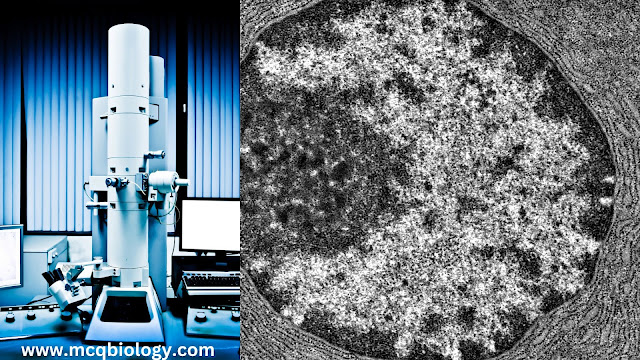1. Fixative osmium tetroxide is used to stabilize
A) Protein
B) Nuclear material
C) Cell structure
D) Dehydration of cell
2. Diameter of metal grid for specimen mount used in
Electron Microscope is
A) 3.05 mm
B) 3.50 mm
C) 3.05 μm
D) 3.50 μm
3. For transmission electron microscopy, thin sections have to be prepared by
A) Rotary microtome
B) Sled microtome
C) Cryomicrotome
D) Ultramicrotome
4. All of the following are true for both TEM and SEM except:
A) The illuminating source is an electron beam
B) The microscope is focused using electromagnetic lenses
C) Can be used to view specimens smaller than 0.2 micrometers
D) The specimen must be sectioned prior to viewing
5. Which of the following type of microscopy is most useful
for viewing the internal structures of unstained specimens?
A) Phase-contrast
B) Bright field
C) Electron
D) Confocal
6. Which instrument is more useful to study the surface
details of a specimen?
A) Phase contrast microscope
B) Scanning electron microscope
C) Light microscope
D) Transition electron microscope
7. Which of the following scientists is credited with the
invention of the electron microscope and awarded the Nobel Prize for the same?
A) J.J. Thompson
B) Louise de Broglie
C) Otto van Borris
D) Ernst Ruska
8. Why are thin sections of specimens necessary in Transmission Electron Microscope?
A) Electrons are negatively charged
B) Electrons have a wave nature
C) Electrons have no mass
D) Electrons have a poor penetrating power
9.The resolving power of a microscope could be enhanced by:
A) Decreasing the wavelength of the radiation used
B) Increasing the refractive index of the medium used
C) Increasing the aperture angle
D) Increasing the wavelength of radiation used or decreasing the aperture angle
10. The specimen can be viewed in live condition in:
A) Phase contrast microscopy
B) Light field microscopy
C) Transmission Electron microscopy
D) Scanning Electron microscopy
Answers:
1. C) Cell structure
2. A) 3.05 mm
3. D) Ultramicrotome
4. D) The specimen must be sectioned prior to viewing
5. A) Phase-contrast
6. B) Scanning electron microscope
7. D) Ernst Ruska
8. D) Electrons have a poor penetrating power
9. A) Decreasing the wavelength of the radiation used
10. A) Phase contrast microscopy
